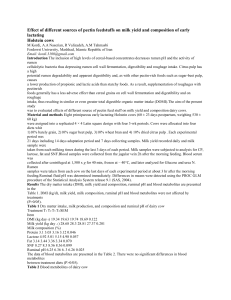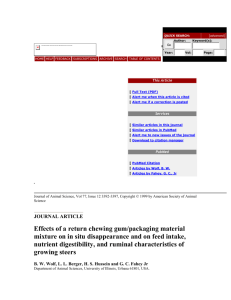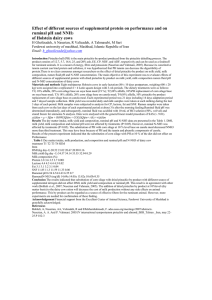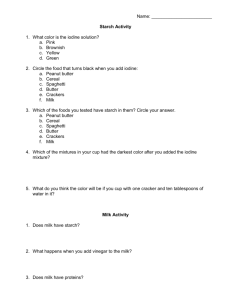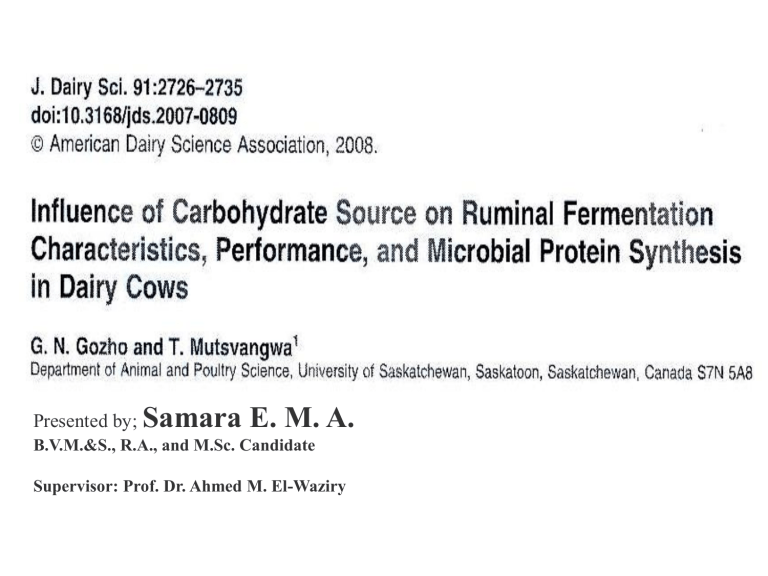
Presented by; Samara E. M. A. B.V.M.&S., R.A., and M.Sc. Candidate Supervisor: Prof. Dr. Ahmed M. El-Waziry Introduction • In ruminants, the energy derived from carbohydrate digestion in the rumen drives microbial protein synthesis and, thus, contributes toward the animal’s protein requirements (Koenig et al., 2003). • Typically, carbohydrates make up 70 to 80% of the dairy cow’s diet (Nocek and Russell, 1988). • In western Canada and the United States, dairy cow diets usually contain barley, corn, wheat, or oats as the main carbohydrate source – They are a cost-effective source of digestible energy. Introduction • These cereal grains differ in their – Starch content (DM basis), • Wheat containing 77% starch, corn 72%, and barley and oats 57 to 58% (Huntington, 1997). – Rates and extents of ruminal starch degradation • 55 to 70% of corn starch, 80 to 90% of barley and wheat starch, and 92 to 94% of oats starch being digested in the rumen (Huntington, 1997). – Starch is the major nutrient that provides energy from these cereal grains. – These important parameters determine nutrient supply to the animal (Hall, 2004). Introduction • Greater dietary concentration of non-structural carbohydrates increases the utilization of ruminal ammonia- N for microbial protein synthesis (Nocek and Russell,1988; Hoover and Stokes, 1991; Nocek and Tamminga, 1991). • Increasing ruminally available energy content of diets for dairy cows has potential to enhance milk production through increased metabolizable nutrient supply, – Increasing microbial protein synthesis in the rumen. • More ruminally degradable starch increased microbial N supply in 2 studies and had no effect in 5 studies (Cabrita et al. (2006). The Hypothesis • Because barley, corn, wheat, or oats differ in their rates and extents of ruminal starch digestion, – Their ability to support microbial protein synthesis in the rumen would differ. The Objective • The objective of this study was – To evaluate the effect of dietary inclusion of barley, corn, wheat, or oats as the principal source of starch on • Microbial N flow to the duodenum. • N balance. • and Performance in dairy cows. Materials and Methods • Animals and Experimental Design – Eight multiparous Holstein cows (676 ± 57 kg of BW;121 ± 17 DIM) • Cows were housed in individually and had free access to drinking water throughout the trial. – Four cows in were fitted with permanent ruminal cannulae • Ruminal fermentation and total tract diet digestibility. – Replicated design with 21-d periods and 4 dietary treatments. • Each 21-d experimental period consisted of 14 d of dietary adaptation and 7 d (d 15 to 21) for sample and data collection. Materials and Methods • Feeding Management – The 4 dietary treatments examined were different cereal grains as the major source of starch, with the concentrate portion of the diet containing barley, corn, wheat, or oats. • All cereal grains were dry rolled. – Experimental diets were fed twice daily at 08:00 and 15:30 h for ad libitum intake. – The ingredient composition and chemical analysis of the experimental diets is shown in Table 1. Materials and Methods • Feeding Management – The main protein sources for the experimental diets were whole canola seed, canola meal, wheat distillers dried grains, and corn gluten meal (Table 1). • The diets were formulated to be iso-nitrogenous at 2.72% N (17% CP). – Whole canola seed was added to the concentrate such that experimental diets would contain 5 to 6% fat (DM basis). – The forage component of the diet was a mixture of barley silage and chopped alfalfa hay. • Forage : concentrate ratio of the diets was 50 : 50 Materials and Methods • Sample Collection – Feed – Fecal – Urine – Ruminal Contents – Ruminal Fluid – Milk – Blood Materials and Methods • Sample Collection – During the 7-d sample and data collection period, individual cow feed intake was recorded daily. – Feed samples were dried at 55°C in an oven for 48 h, ground through a 1-mm screen using a Christy-Norris mill and analyzed for DM, OM, ether extract, Kjeldahl N (AOAC,1990), ADF, and NDF (Van Soest et al., 1991). – Starch concentration of feed and fecal samples was analyzed using a starch assay kit. Materials and Methods • Total Tract Diet Digestibility – Determined by total collection of feces and urine between d 17 and 21 of each experimental period. • Total daily fecal output for each cow was mixed thoroughly before a 2.5% sub-sample was taken and stored at -20°C. – At the end of the trial, frozen fecal sub-samples were thawed, dried at 55°C, and then ground through a 1mm screen using a Christy-Norris mill – Ground fecal samples were then composited per cow for each experimental period and analyzed for OM, CP, EE, starch, ADF, and NDF. Materials and Methods • Sample Collection – Cows were milked twice daily at 05:00 and 15:00 h, and milk weights were recorded during the 7d of data collection period. • Milk production was converted to 3.5% FCM using (0.434 x kg of milk) + (16.216 x kg of milk fat). • Collected into plastic vials that contained a preservative (2-bromo2-nitropropane-1-2-diol). – Milk samples were then pooled daily based on milk yield, and analyzed for CP, lactose, and fat using a near infrared analyzer. Materials and Methods • Ruminal Fermentation Characteristic – Using the ruminally cannulated cows (n=4) – On d 18 of each experimental period, 1000 mL of ruminal contents were collected by manually taking 250 mL of ruminal contents from the • Cranial ventral, caudal ventral, central, and cranial dorsal rumen • At 0 (just before the morning feeding), 2, 4, and 6 h after feeding. – Ruminal fluid samples were obtained by straining ruminal contents through 4 layers of cheesecloth. – Ruminal fluid pH was immediately determined. Materials and Methods • Ruminal Fermentation Characteristic – Ruminal fluid samples were obtained by straining ruminal contents through 4 layers of cheesecloth. • A 5-mL sub-sample of strained ruminal fluid was mixed with chilled 25% meta-phosphoric acid (H2PO4) and stored at -20°C for later determination of VFA. • Another 5-mL sub-sample was mixed with 1% H2SO4 and stored at -20°C for later determination of ammonia-N (NH3-N). Materials and Methods • Ruminal Fermentation Characteristic – At the end of the trial, frozen ruminal fluid sub-samples were thawed at room temperature and then centrifuged at 20,000 x g for 20 min. – Ruminal VFA were separated and quantified by gas chromatography (Varian 3700; Varian Specialties Ltd., Brockville, Ontario, Canada) – Ammonia content of ruminal samples was determined using the method described by Weatherburn (1967) modified to use a microtiter plate reader. Materials and Methods • Sample Collection – Blood samples were collected at 4 h post-feeding on d 19 and 20 of the experimental period from the coccygeal vein of each animal into heparin tubes. – Plasma was prepared immediately after collection by centrifugation of blood at 1,000 x g for 15 min and then stored at -20°C until further analysis. • Plasma urea-N (PUN) and glucose concentration were determined. Materials and Methods • Nitrogen Balance – Total urine output was collected on d 17 using bladder catheters – Urine samples were mixed with concentrated HCl • To prevent microbial degradation and the loss of volatile NH3-N. – Daily urinary output was weighed, mixed thoroughly, and 5% of the output was drawn, pooled for each cow during each collection period, and stored at -20°C until analyzed for total N. – Urine N, Allantoin, Uric acid, total purine derivative (tPD; i.e., allantoin + uric acid) was determined . – Nitrogen retained (NR) was calculated as [ NR = intake N - fecal N - urinary N - milk N ] Materials and Methods • Statistical Analysis – The statistical model used included period, treatment, time, and treatment x time interaction as fixed effects, and cow as a random effect. – Data on DMI, milk yield and composition, ruminal pH, VFA, and NH3-N concentrations, plasma urea nitrogen, and glucose were analyzed using the Proc Mixed procedure of SAS (SAS Institute, 2004) – Least square means were separated using Bonferroni’s procedure in SAS (2004). – Treatment effects were declared significant at P ≤ 0.05 Results and Discussion • Diet Characteristics • DMI, Milk Yield and Milk Composition, and Plasma Metabolites • Ruminal Fermentation Characteristics and Apparent Total Tract Diet Digestibility • Nitrogen Balance and Microbial N Flow Diet Characteristics Apparent Total Digestibility Ruminal Fermentation Characteristics DMI, Milk Yield and Milk Composition, and Plasma Metabolites Nitrogen Balance Microbial N Flow Conclusions • This study demonstrates that feeding barley-, corn-, or oatsbased diet resulted in similar levels of intake but that feeding wheat-based TMR tended to depress DMI. – Consequently fat-corrected milk yield decreased in cows fed wheatbased diets. • Feeding barley- or wheat-based diet depressed milk fat content, but milk fat yield was only depressed with the wheat-based TMR. – However, milk fat yield was not adversely affected in cows on the barley-based TMR because the marginally higher milk yields achieved with this diet compensated for the milk fat depression. Conclusions • In spite of likely differences in ruminally degradable starch contents of these diets, ruminal fermentation characteristics did not differ within the first 6 h after morning feeding. • Nitrogen balance was similar across diets. • The marginally superior production performance with barley- and corn-based diet may have been due to a higher nutrient intake (absorption) in cows on these diets compared with those on wheat-based TMR. – Rather than improved nutrient utilization efficiency. Conclusions • Urine excretion of tPD indicated higher microbial protein availability at the small intestine in cows fed barley- and corn-based diets compared with those fed oats- and wheatbased diets. • The data from this study further demonstrate that, even though we perceive that the kinetics of rumen degradation of rations are a function of the nature and constituents of the feeds, using this information to manipulate rumen microbial protein synthesis does not always yield the expected response. The End Thank you …. for your attention ….
